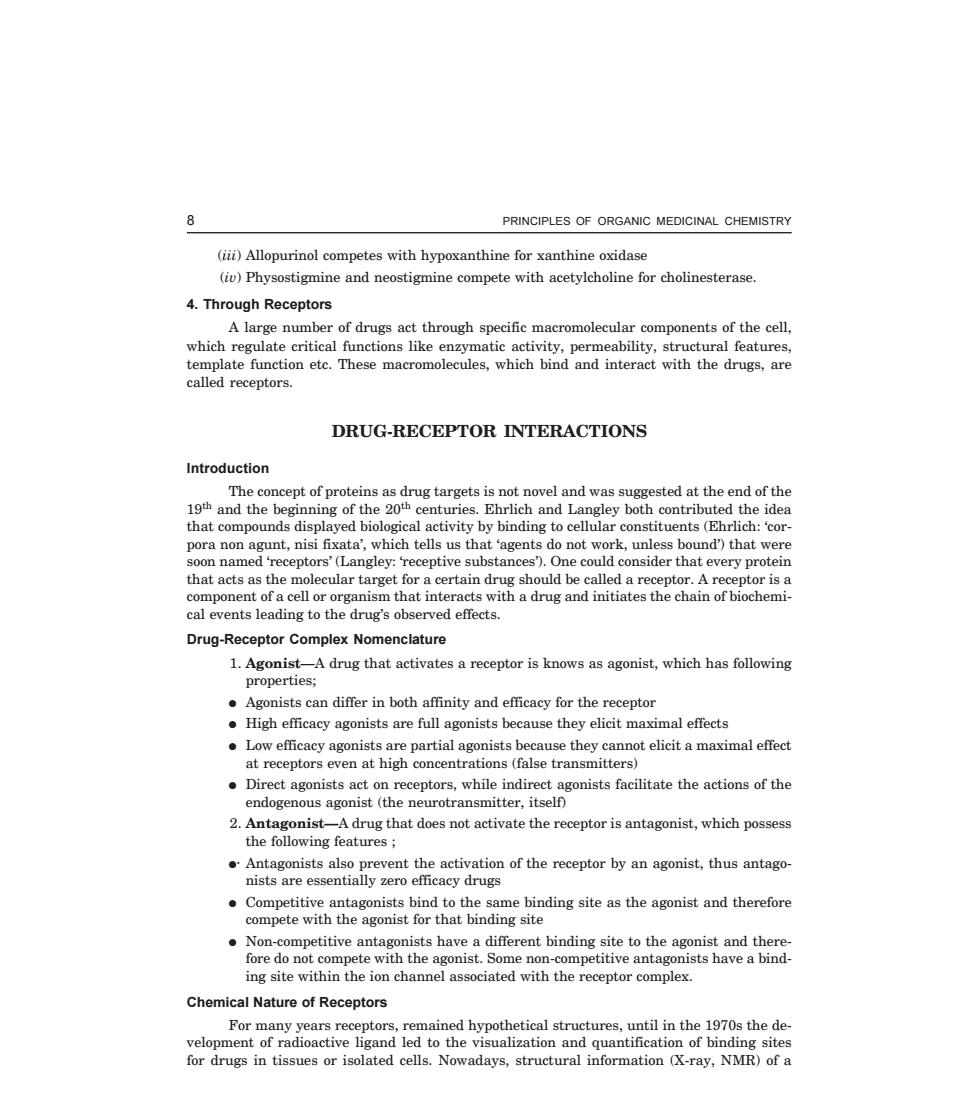正在加载图片...

B PRINCIPLES OF ORGANIC MEDICINAL CHEMISTRY (ii)Allopurinol competes with hypoxanthine for xanthine oxidase (i)Physostigmine and neostigmine compete with acetylcholine for cholinesterase 4.Through Receptors A large number of drugs act through specific macromolecular components of the cell, which regulate critical functions like enzymatic activity,permeability,structural features, template function etc.These macromolecules,which bind and interact with the drugs,are called receptors. DRUGRECEPTOR INTERACTIONS Introduction The conc ggested at the end of the 19th and the be nd La ley both contributed the ides that compounds displaved biological activity by binding to cellular constituents (Ehrlich:cor. pora non agunt,nisi fixata',which tells us that 'agents do not work,unless bound')that were soon named'receptors'(Langley:receptive substances).One could consider that every protein that acts as the molecular target for a certain drug sh nitiates the c em Drug-Receptor Complex Nomenclature 1.Agonist roper drug that activates a receptor is knows as agonist,which has following Agonists can differ in both affinity and efficacy for the receptor High efficacy agonists are full agonists because they elicit maximal effects vefficacy agonists are partial agonists because they cannot elicit a maximal effect nigh concer fals t(the neurotransmitter,its 2.Antagonist- A drug that does not activate the receptor is antagonist,which possess the following features .Antagonists also prevent the activation of the receptor by an agonist,thus antago- nists are essentially zero efficacy drugs Competitive antagonists bind to the ame binding site as the agonist and therefore comnete with the agonist for that binding site ·Non nists have a different binding ago ith the ists have a bind ing site within the ion channel associated with the receptor complex. Chemical Nature of Receptors 4a1 ntil in the 1970s the de and antification of binding si for drugs in tissues or isolated cells.Nowadays,structural information (X-ray,NMR)of a 8 PRINCIPLES OF ORGANIC MEDICINAL CHEMISTRY C-8—N-CHEMI\CHE2-1.PM5 (iii) Allopurinol competes with hypoxanthine for xanthine oxidase (iv) Physostigmine and neostigmine compete with acetylcholine for cholinesterase. 4. Through Receptors A large number of drugs act through specific macromolecular components of the cell, which regulate critical functions like enzymatic activity, permeability, structural features, template function etc. These macromolecules, which bind and interact with the drugs, are called receptors. DRUG-RECEPTOR INTERACTIONS Introduction The concept of proteins as drug targets is not novel and was suggested at the end of the 19th and the beginning of the 20th centuries. Ehrlich and Langley both contributed the idea that compounds displayed biological activity by binding to cellular constituents (Ehrlich: ‘corpora non agunt, nisi fixata’, which tells us that ‘agents do not work, unless bound’) that were soon named ‘receptors’ (Langley: ‘receptive substances’). One could consider that every protein that acts as the molecular target for a certain drug should be called a receptor. A receptor is a component of a cell or organism that interacts with a drug and initiates the chain of biochemical events leading to the drug’s observed effects. Drug-Receptor Complex Nomenclature 1. Agonist—A drug that activates a receptor is knows as agonist, which has following properties; Agonists can differ in both affinity and efficacy for the receptor High efficacy agonists are full agonists because they elicit maximal effects Low efficacy agonists are partial agonists because they cannot elicit a maximal effect at receptors even at high concentrations (false transmitters) Direct agonists act on receptors, while indirect agonists facilitate the actions of the endogenous agonist (the neurotransmitter, itself) 2. Antagonist—A drug that does not activate the receptor is antagonist, which possess the following features ; · Antagonists also prevent the activation of the receptor by an agonist, thus antagonists are essentially zero efficacy drugs Competitive antagonists bind to the same binding site as the agonist and therefore compete with the agonist for that binding site Non-competitive antagonists have a different binding site to the agonist and therefore do not compete with the agonist. Some non-competitive antagonists have a binding site within the ion channel associated with the receptor complex. Chemical Nature of Receptors For many years receptors, remained hypothetical structures, until in the 1970s the development of radioactive ligand led to the visualization and quantification of binding sites for drugs in tissues or isolated cells. Nowadays, structural information (X-ray, NMR) of a